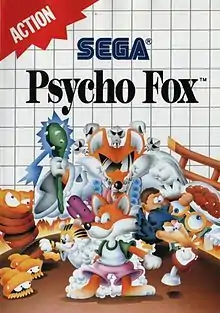Psycho Fox
Psycho Fox is a video game published by Sega for the Master System in 1989. In Brazil, Tectoy released the game as Sapo Xulé: Os Invasores do Brejo (translated as "Xulé Frog: Invaders of the Swamp"), in which Psycho Fox and his friends were replaced by Sapo Xulé (a Brazilian comic frog character), a pig, a turtle and a mouse.
| Psycho Fox | |
|---|---|
 North American cover art of Psycho Fox | |
| Developer(s) | Vic Tokai |
| Publisher(s) | Sega TecToy (Brazil) |
| Director(s) | Toshihisa Hasegawa |
| Programmer(s) | Shoji Suzuki |
| Composer(s) | Fumito Tamayama Hiroto Kanno |
| Platform(s) | Master System |
| Release | |
| Genre(s) | 2D action Platformer |
| Mode(s) | Single-player |
Plot
Among a group of fox priests who worship the Inari Daimyojin (Fox Deity), one evil fox named Madfox Daimyōjin infiltrated his way to the highest ranks and took over the shrine. After seizing power, Madfox corrupted the land and created hordes of creatures. One young fox (who would earn the name Psycho Fox) has been chosen by his fellow people to rid the land of this evil deity.[1]
Gameplay
The player takes control of Psycho Fox in this side-scrolling video game. Psycho Fox must get from the left-hand side of the level to the right-hand side of the level with many enemies in the way. He can use a Shinto stick to change into other characters/animals, namely a hippopotamus, a monkey or a tiger, each of which has its own special ability. The hippopotamus is slow and cannot jump very high, but can punch through special destructible blocks in the game world. The monkey can jump higher than the other creatures and the tiger can run faster. Psycho also has an ally named Birdfly, who can be used as armor or as a boomerang. If Psycho is hit while carrying Birdfly, Birdfly goes away and the player does not lose a life.
Reception
| Publication | Score |
|---|---|
| Mean Machines | 90%[2] |
| S: The Sega Magazine | 93%[3] |
The game was positively reviewed by Mean Machines magazine mainly for its addictiveness and good quality graphics.[3] S: The Sega Magazine described it in 1990 as "one of the best games for the Master System".[4] Allgame have a rating of 3.5 out of 5 stars noting the game being fairly lengthy and the players have the choice between two routes in each level and giving criticism to the basic action being repetitious, the controls being a little frustrating and the level design not particularly innovative concluding “Overall, this is a fun, if largely unoriginal game.”[5]
See also
- Kid Kool – Vic Tokai's Nintendo Entertainment System equivalent of Psycho Fox
- DecapAttack – The spiritual successor to Psycho Fox for the Sega Genesis.
References
- Psycho Fox Manual. Sega of America. 1990. p. 2.
- "Psycho Fox - Sega Review" (PDF). Mean Machines. No. 11. August 1991. p. 78.
- "Psycho Fox - Game Test". S: The Sega Magazine. No. 3. 1990.
- "Psycho Fox - review by S: The Sega Magazine - Reviews - SMS Power!". www.smspower.org. Retrieved 2019-02-01.
- Brett Alan Weiss. "Psycho Fox Review". Allgame. Archived from the original on November 15, 2014. Retrieved January 9, 2021.